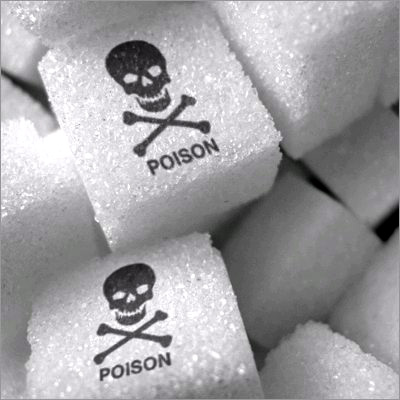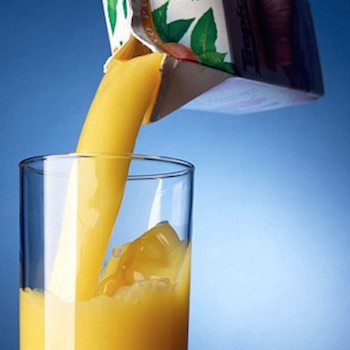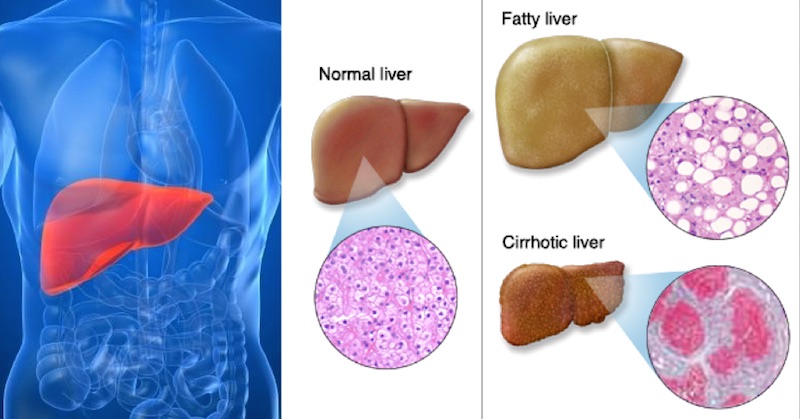Fatty Liver Disease: What Is It, Are You At Risk, Causes, And How To Lower Your Risk
Last updated on
When your liver is composed of 5 to 10 percent fat by weight, you have non-alcoholic fatty liver disease, or NAFLD. One of the functions of the liver is to produce bile so the body can digest fats, break down hormones, cleanse the blood, and store vitamins and minerals.
With fatty liver disease, the liver is unable to adequately break down the fats it has extracted from the blood. The fats accumulate and the liver becomes enlarged. NAFLD is a very common liver disorder. Causes and increased risk factors for NAFLD include:
- Age
- Alcohol consumption
- Diabetes
- Genetics
- High cholesterol
- High triglycerides
- Obesity
- Poor diet and/or malnutrition
- Sedentary lifestyle
- Some medications
- Thyroid disorders
When you have inflammation and cell damage in your liver in addition to NAFLD, you are diagnosed with non-alcoholic steato-hepatitis (or NASH). Between 2 and 5 percent of Americans have NASH.
The National Institute of Health (or NIH), estimates that between 20 and 30 percent of adults in western countries are afflicted with NAFLD. Although the incidence is lower in eastern countries, it is on the rise. The incidence also rises with age, although it is increasingly more common at younger ages due to the high-fat diet consumed by most Americans.
Read: 7 Early Warning Signs Of Fatty Liver Disease And Natural Remedies.
Leading Cause Of Non-Alcoholic Fatty Liver Disease
In your quest for a healthier diet, the first ingredient to eliminate would be fructose—the sugar found in everything from high-fructose corn syrup (HFCS) and packaged fruit juice to agave syrup and honey. It’s harmful when consumed in excess—which is exactly what many (if not most) Americans do.

Since all fructose gets shuttled to your liver, and, if you eat a typical Western-style (SAD) diet, you consume high amounts of it, fructose ends up taxing and damaging your liver in the same way alcohol and other toxins do. In fact, fructose is virtually identical to alcohol with regard to the metabolic havoc it wreaks.
According to Dr. Robert Lustig, a neuroendocrinologist in the Division of Endocrinology at the University of California, fructose is a “chronic, dose-dependent liver toxin.” And just like alcohol, fructose is metabolized directly into fat—not cellular energy, like glucose.
His findings were published in the Journal of the Academy of Nutrition and Dietetics, where Dr. Lustig explained the three similarities between fructose and its fermentation byproduct, ethanol (alcohol):
- Your liver’s metabolism of fructose is similar to alcohol, as they both serve as substrates for converting dietary carbohydrate into fat, which promotes insulin resistance, dyslipidemia (abnormal fat levels in the bloodstream), and fatty liver.
- Fructose undergoes the Maillard reaction with proteins, leading to the formation of superoxide free radicals that can result in liver inflammation similar to acetaldehyde, an intermediary metabolite of ethanol.
- By “stimulating the ‘hedonic pathway’ of the brain both directly and indirectly,” Dr. Lustig noted, “fructose creates habituation, and possibly dependence; also paralleling ethanol.”
How Excess Fructose Directly Contributes To NAFLD
Writing in the journal Hepatobiliary Surgery and Nutrition, researchers noted that the rapid rise in NAFLD prevalence supports the role of environmental factors.
The overconsumption of high-fructose corn syrup (HFCS) in soda is associated with NAFLD, while the study also concluded “ingested carbohydrates are … more likely to directly contribute to NAFLD than dietary fat intake.”
The fat-forming and pro-inflammatory effects of fructose appear to be due to transient ATP (the chemical storage form of energy) depletion, according to the study. This, in turn, leads to uric acid formation.
Fructose increases uric acid through a complex process that causes cells to burn up their ATP rapidly, leading to “cell shock” and increased cell death. After eating excessive amounts of fructose, cells become starved of energy and enter a state of shock, just as if they have lost their blood supply.
Cells that are depleted of energy become inflamed and more susceptible to damage from oxidative stress. Fat cells actually become “sickly,” bloating with excessive amounts of fat.
Massive cellular die-off leads to increased uric acid levels. Uric acid is a normal waste product found in your blood. It functions both as an antioxidant and as a pro-oxidant once inside your cells.
So, if your uric acid levels are too high, it tends to increase to harmful levels inside your cells as well, where it acts as a pro-oxidant. According to Dr. Richard Johnson, who conducted years of research on the role of fructose in obesity uric acid appears to take on a lead role in creating health problems when it reaches levels in your body of 5.5 mg per dl or higher.
At this level, uric acid is associated with an increased risk for developing high blood pressure, as well as diabetes, obesity, and kidney disease. The ideal range for uric acid lies between 3 to 5.5 mg per dl.
The connection between fructose consumption and increased uric acid is so reliable that a uric acid level taken from your blood can actually be used as a marker for fructose toxicity. I now recommend that a uric acid level be a routine part of your blood screening.
Read: 7 Early Warning Signs Of Fatty Liver Disease And Natural Remedies.
One Sugary Drink Daily Increases Your Risk Of NAFLD
Sugary beverages, including not only soda but also packaged fruit juice, lemonade, fruit punch, and the like, are a major source of fructose in the US diet.

Sugary drinks are likely one major factor in why even children are developing NAFLD at alarming rates. The longer you have NAFLD, the more likely it is to progress into more serious disease like liver fibrosis (accumulation of abnormal fibrous tissue), cirrhosis (accumulation of scar tissue), and NASH.
In fact, the Hepatobiliary Surgery and Nutrition study linked HFCS consumption to the severity of fibrosis in patients with NAFLD. Therefore, it’s very concerning that children are developing this so early in their lives.
The following facts about pediatric NAFLD are disturbing:
- Nearly 10 percent of US children have NAFLD
- This includes 1 percent of 2- to 4-year-olds and 17 percent of 15- to 19-year-olds
- Approximately 38 percent of obese children have NAFLD
- Children with NAFLD are at particular risk of complications and poor prognosis, including the need for a liver transplant in adulthood
How Much Fructose Is Too Much?
Most overweight Americans have some degree of insulin and leptin resistance. This also includes people with diabetes, and many individuals with high blood pressure or high cholesterol (the same individuals at increased risk of NAFLD).
If you fall into this category, it would be prudent for you to restrict your fructose consumption to about 15 grams of fructose per day from all sources. Remember, fructose isn’t only found in sugary beverages; it’s also found in many processed foods and even “healthy” sweeteners like agave.
Those who are normal weight and relatively healthy may also benefit from reducing their intake of fructose to 25 grams a day, particularly from foods containing high-fructose corn syrup or sugar, as the effects of high sugar and HFCS intake may have effects that build up over time.
Naturally, fruits also have fructose but contain many beneficial nutrients and antioxidants. For someone who is obese or suffering from NAFLD, one has to be careful with eating fruits that have substantial fructose content.
Some fruits, such as lemons and limes, have minimal fructose content and are safe. Other fruits, such as grapefruit, kiwifruit, and berries, also have relatively low fructose content and high levels of nutrients. However, fruit juices, dried fruits, and some fruits that are rich in fructose (such as pears, red apples, and plums) should be eaten relatively sparingly.
According to Dr. Johnson, if you exercise regularly, a small amount of fructose can actually be quite beneficial, because the fructose will accelerate glucose absorption in your gut and improve muscle performance. But it really depends on how your body metabolizes the fructose.
Your body normally cannot absorb fructose well. But the more fructose you eat, the more the transporters that allow for fructose uptake in your gut are turned on. Hence, the more fructose your body will absorb. Lean children, for instance, tend to only absorb about half of the fructose they consume, whereas obese children who have fatty liver disease absorb close to 100 percent.
Read: 7 Early Warning Signs Of Fatty Liver Disease And Natural Remedies.
Read more about Liver Support Food and How To Eat Bitters To Heal The Liver.
Go here >> For a Complete Guide To Doing A Liver Cleanse
.
This article is shared with permission from our friends at positivemed.com.
Some of the links I post on this site are affiliate links. If you go through them to make a purchase, I will earn a small commission (at no additional cost to you). However, note that I’m recommending these products because of their quality and that I have good experience using them, not because of the commission to be made.


































 JOIN OVER
JOIN OVER
Comments